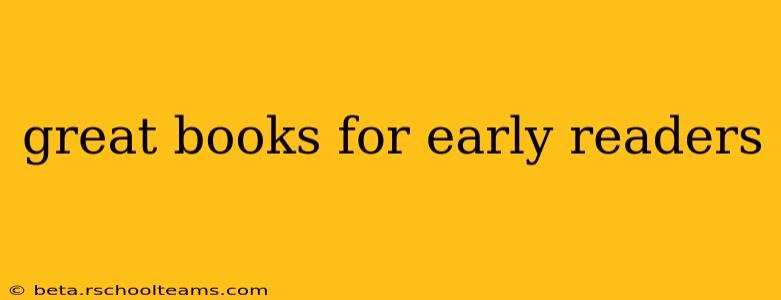Choosing the right books for early readers is crucial in sparking a lifelong love of reading. It's about finding engaging stories with captivating illustrations that match a child's developing reading skills and interests. This guide will help you navigate the world of early reader books, offering suggestions and tips to make reading time a joyful experience.
What Makes a Great Book for Early Readers?
A great early reader book balances engaging content with manageable text. Look for books with:
- Repetitive phrases and patterns: These help build confidence and fluency. Predictable text allows children to anticipate what comes next, encouraging them to participate actively in the reading process.
- Simple sentence structures: Short, declarative sentences are easier to understand and decode.
- High-frequency words: Focus on books that utilize commonly used words to build vocabulary.
- Large, clear font: Easy-to-read fonts reduce eye strain and frustration.
- Colorful and engaging illustrations: Pictures help young readers understand the story even if they struggle with some words. Illustrations can also spark imagination and discussion.
- Themes that resonate: Books about familiar experiences, animals, or relatable characters are often more engaging for young children.
Top Picks for Early Readers: Age-Appropriate Selections
The best books will depend on your child's individual reading level and interests, but here are some popular categories and examples:
Picture Books with Simple Text:
These books feature larger illustrations and minimal text, perfect for younger children just beginning their reading journey. Examples include classics like "Brown Bear, Brown Bear, What Do You See?" by Bill Martin Jr. and Eric Carle, and "The Very Hungry Caterpillar" by Eric Carle. These books use repetitive phrases and vibrant images to engage young learners.
Levelled Readers:
Many publishers offer leveled readers categorized by reading level. These books provide a structured approach to gradually increasing complexity. Look for series like "I Can Read!" or "Step into Reading," which offer a range of titles across different levels.
Books About Animals:
Animals are always a hit with young readers! Books featuring popular animals, such as "Click, Clack, Moo: Cows That Type" by Doreen Cronin or "Dear Zoo" by Rod Campbell, often have engaging stories and simple text.
Books with Familiar Themes:
Books that reflect everyday experiences, such as going to school, making friends, or dealing with emotions, are relatable and comforting for young children. Look for books that address common childhood themes in a positive and supportive way.
H2: What are some good books for beginning readers ages 4-5?
For 4-5-year-olds, focus on books with simple sentences, repetitive phrases, and lots of pictures. Titles like "The Cat in the Hat" (Dr. Seuss), "Corduroy" (Don Freeman), and books from the "Little Golden Books" series are excellent choices. These books are designed to be engaging and build foundational reading skills.
H2: What are some good books for beginning readers ages 5-6?
Children aged 5-6 are often ready for slightly more challenging texts. Look for books with slightly longer sentences and a wider vocabulary, but still with plenty of visual support. "Frog and Toad Are Friends" (Arnold Lobel) and books from the "Elephant and Piggy" series (Mo Willems) are great options in this age group.
H2: How do I choose books based on my child's reading level?
Pay attention to your child's reading fluency, comprehension, and vocabulary. If they struggle with a particular book, try a simpler one. If they find a book too easy, challenge them with a slightly more advanced title. Observe their engagement; are they enjoying the story and the pictures? A good book will hold their attention and encourage them to keep reading. Many libraries and bookstores offer leveled reading lists or recommendations based on age and reading ability.
H2: What if my child isn't interested in reading?
Make reading a fun and enjoyable experience! Read aloud together, visit the library regularly, and let your child choose books that interest them. Don't force them to read; instead, create a positive association with books and reading. Consider incorporating interactive elements, like puppets or dramatic readings, to make reading more engaging.
Conclusion: Nurturing a Lifelong Love of Reading
Choosing the right books for early readers is a key step in nurturing a lifelong love of reading. By selecting age-appropriate books with engaging stories and supportive illustrations, you can help your child develop essential literacy skills and cultivate a passion for the written word that will last a lifetime. Remember, the most important thing is to make reading fun and enjoyable!
